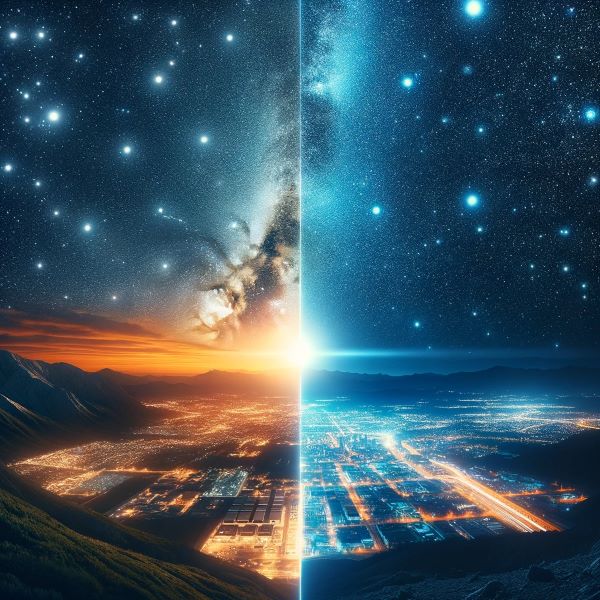What do astronomers mean by light pollution?
There are many different terms that astronomers use in relation to astronomy, and some of them can be confusing. One term that we use a lot is light pollution, which is typically considered as a bad thing when you’re trying to get a good view of the night sky. Even the brightest stars in the night sky can be affected by light pollution, so it’s important you try and avoid areas with a high amount of it.
But what exactly is light pollution, and how does it affect our stargazing? Well, if you want to get back to viewing dark skies as soon as possible, then you’ll probably want to know.
What do astronomers mean by light pollution?

Light pollution is quite simply defined as artificial light in our sky that is caused by humans. Examples of light pollution causes are our street lights, skyscrapers and other light sources, and they have a massive effect on the night skies above us.
Whilst most conservationists are concerned about protecting wildlife and our environment on Earth, sometimes light pollution is overlooked as a lesser problem. However, it has increased in quite a drastic fashion over the last century, making the night sky impossible to see in many cities.
Even the most powerful telescopes can struggle to see anything in a heavily light polluted city (check here for our high end telescope recommendations). There are a few examples of light pollution that stick out too.
Examples of Light Pollution
Some people only think of streetlights when thinking about light pollution, but the truth is that there is much more than this. Some people define light pollution as the unnecessary use of light, however there are many causes of it that may be deemed necessary.
- Street Lights – The first thing people think of when they image light pollution is street lights. They are one of the main causes of light pollution.
- Car Lights – Car Lights are a major cause of light pollution, especially if you consider the build up of lights in big cities. An example of this is Bangkok, which has excessive light pollution, partially caused by it’s abundance of traffic around the city.
- Skyscrapers – You could argue that skyscrapers are necessary, but they are still a cause of light pollution, especially in heavily built up areas.
- Advertising boards – An example of one that might not actually be necessary is advertising signs and boards. Do they really need to be illuminated during the night, being a major contributor to light pollution?
Types of Light Pollution
As well as different sources of light pollution, there are also different types of light pollution that we categorize too. They are;
- Light Trespass – Like it sounds, this describes when light makes it to an area where it is unwanted. A good example of this is if you live near built up city area, and the light from skyscrapers or advertising makes it into your flat or condo window – this is light trespass.
- Skyglow – Most relevant to us as astronomers, Skyglow is the effect of artificial light on our ability to see the sky. This brightening of the sky is caused by many things, and is especially present around built up city areas.
- Glare – Glare is more serious than light trespass. It describes when excessive light actually causes someone visual problems, either pain or just having to squint your eyes. Car headlights would probably be the best example of this.
What does this mean for amateur astronomers?
For astronomers, this means that we can’t see into the sky clearly and get a good view of the night sky, as it is obstructed by light. For those in the city, it’s probably best to travel outside of the city center and reduce the amount of light pollution surrounding you, which can give you a clearer view of the sky.
What country has the worst light pollution?
Singapore is said to have the worst light pollution of any country – you can barely see the stars when you look up at the night sky in Singapore. It’s actually said that it’s not possible to see the milky way in Singapore anywhere in the country due to the airport and financial district.
How can we reduce light pollution?
Although they aren’t a good example in many other areas, North Korea has set a good standard for light pollution. The country has very low light pollution across the country, because they turn the lights off during the night time.
Is light pollution harmful?
As well as having an effect on humans, light pollution is also harmful in other ways. It’s a waste of energy, and it also has an effect on wildlife, particularly birds.
Where is the least light pollution?
Certain countries in Africa, like Madagascar, have very minimal light pollution. You can get a clear view of the night sky in these countries.
Is there anything good about light pollution?
Some studies have shown that there are good side effects of light pollution – some birds have used the extra light to help them hunt for food. However, the bad effects of light pollution likely outweigh the good.
The Wrap Up
The reality is that light pollution has been getting progressively worse for decades, especially within major cities across the globe. And what’s the result of light pollution?
Well, one example is its effect on human health. Light pollution has been linked to anxiety, migraine and a whole host of other negative effects that it might have on the human body. So, it might be time that we stop projecting so much light into the night sky.